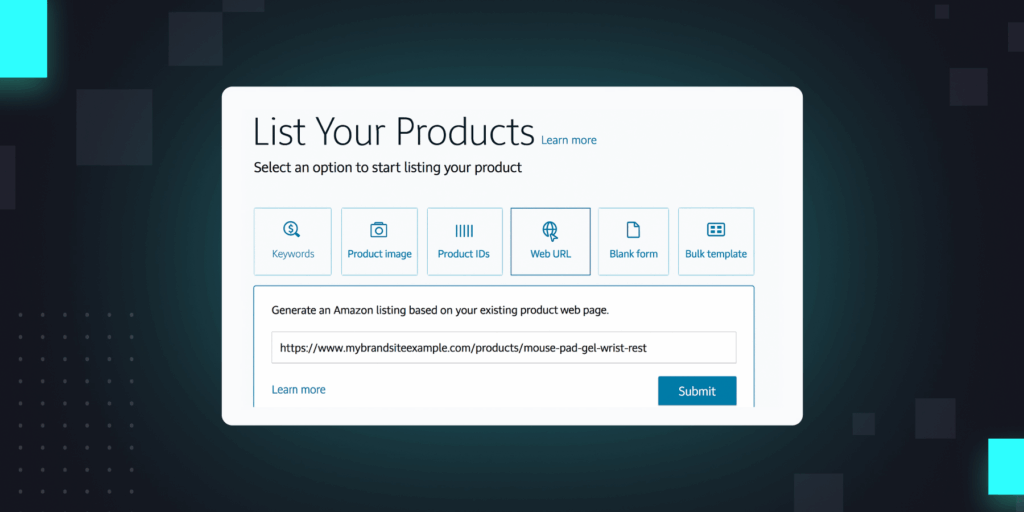What is Amazon’s Choice? Amazon’s Choice is a badge that appears next to a product in search results. Essentially, an Amazon’s Choice product gets Amazon’s seal of approval. It tells shoppers that a product is high quality, at least in Amazon’s view.
Amazon’s Choice is decided algorithmically, which means that you don’t have to get lucky and hope an Amazon employee stumbles across your product in order to get the badge. In theory, anyone with exceptional metrics can get it.
For brands, achieving that Amazon’s Choice label might be the surest way to stand out in a crowded page of search results. Here’s what we know about how the badge works—and how you might be able to get it for yourself, too.
Why does Amazon’s Choice matter?
On Amazon, anything you can do to help your product stand out is a big win. The Amazon’s Choice badge, like the Best Seller badge, differentiates your product from your competitors.
It also creates a sense of trust among shoppers who are probably inundated with a wealth of buying options.
The data backs this up. Recently, the e-commerce data analysis company Profitero found that Amazon’s Choice badges increased the sales conversion rate of a product by 25%. Meanwhile, it increased traffic to product detail pages by 17%.
What factors go into the Amazon’s Choice badge?
Amazon’s Choice badges are awarded based on an internal Amazon algorithm, and Amazon doesn’t disclose all of the metrics that it accounts for.
But industry experts have figured out a few key factors that seem to influence your chance of becoming an Amazon’s Choice product. They are:
- Search results positioning: Is your product already indexing highly in organic rankings?
- Star rating: You probably need at least 4.3-star rating to be eligible.
- Number of reviews: Make sure you have far more than just a few dozen reviews.
- Sales volume and velocity. Amazon tends to prioritize products that are already trending in popularity.
- Return rate: Do shoppers seem satisfied with your products once they get them?
- Pricing: How good of a deal is it?
- Availability: How often is your product in stock? Do you have an Amazon Prime badge?
If you want Amazon to award you an Amazon’s Choice badge, you need to be sure your product is performing well across all of these metrics. That means regularly auditing your account, and being alert to any sudden fluctuations.
If you fall behind your competition on any of these metrics, your chances of winning that Amazon’s Choice badge will probably drop significantly.
How do I manage my inventory for Amazon’s Choice?
The good news is, monitoring your metrics on Amazon doesn’t have to be hard. To start, let’s take that last factor in Amazon’s Choice badging: inventory management.
If you find yourself often running into stockouts, then you are unlikely to get the Amazon’s Choice badge. So how do you ensure you always have plenty of inventory on hand?
One way to do this is to tie together your advertising to your inventory levels. Amazon automatically pauses your Sponsored Products ads if you run out of stock, but it doesn’t do the same for Sponsored Brands, Sponsored Display, or DSP ads. You therefore need to devise your own system of pausing ads on low-stock products.
The best way is to write automated rules that automatically pause or reduce ad spend when your inventory levels are low. That keeps you from selling out your inventory, and ensures you stay in Amazon’s good graces. It’s easy to write rules that pause ad spend based on inventory in the Intentwise Ad Optimizer.
How do return rates impact Amazon’s Choice status?
Tracking your return rates is another critical skill set that can help you get an Amazon’s Choice badge. Products need to maintain a low return rate in order to qualify for Amazon’s Choice.
How do you do this? We recommend creating a dashboard that maps out all of your product return rates and flags any product whose rate is high or increasing gives you a good starting place.
Return rates can be lowered in a number of ways: If customers are often complaining about orders arriving damaged, consider changing your packaging. If many are surprised by the size of color of your product, you might need to improve your product photos.
For what it’s worth, tracking return rates is easy in Intentwise Analytics Cloud. We can conduct a review sentiment analysis for you. In our analyses, we’ll examine:
- Brand sentiment analysis: The overall impression of your brand, across every ASIN, focused on color, size, price, and other attributes.
- ASIN-level analysis: The same analysis at the product level.
- Competitor-level analysis: For any brands you compete with, we’ll compare how shoppers feel about you vs. how they feel about your competitors.
How does content play a role in Amazon’s Choice?
Your chances of getting an Amazon’s Choice badge are much higher if you’ve optimized your product page. That’s because an optimized product page—with high-quality images and clear descriptions—will climb in Amazon’s organic rankings, therefore improving your shot at Amazon’s Choice.
How do you know if your listings are all the way optimized? We recommend paying close attention to the conversion rates on your product page. If those conversion rates are far below those of your competitors, it probably means too many shoppers are bouncing off of your page. Amazon’s algorithm knows this, and it will lower your organic rankings accordingly.
How do you compare your conversion rates to your competitors? One trick is to use Amazon’s Search Query Performance report, which we broke down in a recent webinar.
For more detail on improving your content, our webinar on content strategy will give you a good place to start. Intentwise also offers a Content Analytics service that can help score your product pages for you.
How long does the Amazon’s Choice badge last for?
One quirk of the Amazon’s Choice badge is that it doesn’t last forever. Once it shows up on your product page, it might stay there for many months, or it might disappear in a matter of days or weeks.
These badges come and go as the Amazon algorithm changes, and they are therefore not something to base your business around. If you get one—great. If not—it isn’t the end of the world.
It’s worth understanding how the Amazon’s Choice badge works whether or not you actually get it. That’s because the metrics you need to improve in order to get the badge (inventory management, return rates, etc) also help your presence on Amazon writ large.
Figuring out how to track these metrics, and creating real-time alerts in case anything changes, is well worth your time. Even if you don’t end up with an Amazon’s Choice badge in the end, it’ll still give a boost to your business.
(Want more content like this? Be sure to subscribe to our newsletter.)







